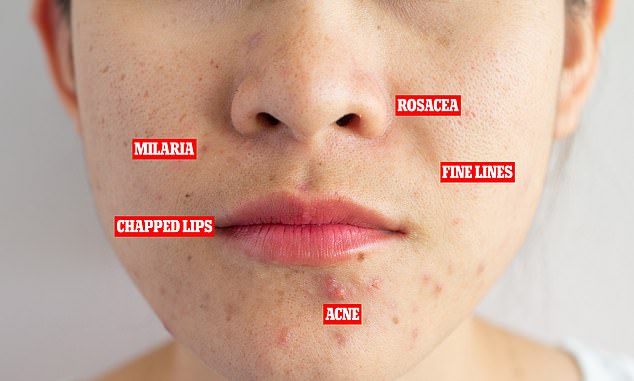While wearing a mask is an essential part of your daily routine amid the Covid-19 pandemic, using a covering along with spending more time cooped up inside is not doing your skin any good.
You might have noticed an increase in breakouts, commonly known as ‘maskne’, and tried to combat it by cleansing and cleaning your reusable mask religiously, but the effects can be more long-lasting than just a few blemishes.
Dr Yannis Alexandrides, founder and Surgical Director of 111 Harley St, has revealed to Femail how mask wearing can cause fine lines to develop and make you look older through a combination of skin flare-ups.
Here, he reveals the most common skin problems caused by face masks and what you can do to prevent them, while remaining safe.
Dr Yannis Alexandrides, Founder and Surgical Director of 111 Harley St, has revealed to Femail how mask wearing can cause fine lines to develop and cause a combination of skin flare-ups, including sweat rash, inflammation and acne
FINE LINES
If you feel those tell-tale lines are looking a little deeper recently or some new ones have cropped up, the chances are it’s not just all down to lockdown stress.
‘Premature ageing essential comes down to inflammation within the skin,’ Dr Yannis explained.
‘This inflammation can easily be caused by PPE masks, which have been proven to degrade the epidermal barrier through physical abrasion.’
The problem arises not while wearing your mask, but when you take it off because the skin’s natural defences are down.
‘This means that bacteria, pollution and other harmful toxins can enter the skin and cause oxidative stress, stimulating an inflammatory response,’ he said.
‘It also means the barrier function is compromised, making transdermal water loss more prevalent too – the result is drier, more dehydrated skin, giving you the instant appearance of ageing.’
The solution: Try a silk face mask that will be gentler on your skin and less abrasive than disposable or other material versions.
MILIARIA
Also known as sweat rash, this comes about after blockages and/or inflammation in the sweat glands.
The face masks we have been wearing retains the CO2 that we expel and therefore creates a humid environment for the areas of our face which are covered.
The increase in temperature can trap dead skin, dirt and oils into the glands which will often cause a rash to break out.
Milaria is commonly mistaken for Maskne. In actual fact, most people suffer from the first rather than the latter.
The solution: This, again, comes down to physical abrasion and can be prevented by using a silk mask.
ROSACEA
Rosacea causes small and red bumps on the face and face masks have been said to trigger flare-ups due to an alteration in the skin’s microbiome.
Having material rub against your skin can cause friction which stimulates the hypersensitive nerves which surround the blood vessels in your face.
The solution: A nourishing cream that creates a layer between the skin and material will help calm sensitive and reduce any further friction
CHAPPED LIPS
Physical abrasion from the material of a mask dries the skin and degrades the epidermal barrier, which is your first red flag for chapped lips.
Additionally, the trapped air in the mask, which heats up the region and causes bacteria overgrowth, leads to both dry and damaged lips.
The solution: A nourishing lip serum and thick salve will replenish lost moisture and protect the area from further damage.
MASKNE
It is now widespread knowledge that masks are not good news for the skin, with a particular emphasis on the blemish-inducing effects of the masks now commonly referred to as ‘maskne’.
Maskne occurs for a variety of reasons – the physical abrasion the material of the mask can have on the skin – which both dries the skin and degrades the epidermal barrier – as well as the trapped air in the mask, which heats up the region and causes bacteria overgrowth. It is the perfect environment for acne to occur.
